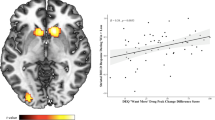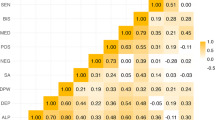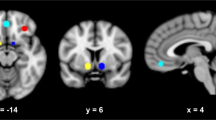Abstract
Genetic factors, externalizing personality traits such as impulsivity, and brain processing of salient stimuli all can affect individual risk for alcoholism. One of very few confirmed genetic association findings differentiating alcoholics from non-alcoholics is with variants in the inhibitory γ-amino butyric acid α2 receptor subunit (GABRA2) gene. Here we report the association of two of these GABRA2 variants with measures of alcohol symptoms, impulsivity and with insula cortex activation during anticipation of reward or loss using functional magnetic resonance imaging (fMRI). In a sample of 173 families (449 subjects), 129 of whom had at least one member diagnosed with alcohol dependence or abuse, carriers for the G allele in two single-nucleotide polymorphisms (SNPs) and haplotypes were more likely to have alcohol dependence symptoms (rs279858, P=0.01; rs279826, P=0.05; haplotype, P=0.02) and higher NEO Personality Inventory-Revised (NEO-PI-R) Impulsiveness scores (rs279858, P=0.016; rs279826, P=0.012; haplotype, P=0.032) with a stronger effect in women (rs279858, P=0.011; rs279826, P=0.002; haplotype, P=0.006), all P-values are corrected for family history and age. A subset of offspring from these families (n=44, 20 females), genotyped for GABRA2, participated in an fMRI study using a monetary incentive delay task. Increased insula activation during reward (r2=0.4; P=0.026) and loss (r2=0.38; P=0.039) anticipation was correlated with NEO-PI-R Impulsiveness and further associated with the GG genotype for both SNPs (P's<0.04). Our results suggest that GABRA2 genetic variation is associated with Impulsiveness through variation of insula activity responses, here evidenced during anticipatory responses.
This is a preview of subscription content, access via your institution
Access options
Subscribe to this journal
Receive 12 print issues and online access
$259.00 per year
only $21.58 per issue
Buy this article
- Purchase on Springer Link
- Instant access to full article PDF
Prices may be subject to local taxes which are calculated during checkout

Similar content being viewed by others
References
Krystal JH, Staley J, Mason G, Petrakis IL, Kaufman J, Harris RA et al. Gamma-aminobutyric acid type A receptors and alcoholism: intoxication, dependence, vulnerability, and treatment. Arch Gen Psychiatry 2006; 63: 957–968.
Grobin AC, Matthews DB, Devaud LL, Morrow AL . The role of GABA(A) receptors in the acute and chronic effects of ethanol. Psychopharmacology (Berlin) 1998; 139: 2–19.
Agrawal A, Edenberg HJ, Foroud T, Bierut LJ, Dunne G, Hinrichs AL et al. Association of GABRA2 with drug dependence in the collaborative study of the genetics of alcoholism sample. Behav Genet 2006; 36: 640–650.
Bauer LO, Covault J, Harel O, Das S, Gelernter J, Anton R et al. Variation in GABRA2 predicts drinking behavior in project MATCH subjects. Alcohol Clin Exp Res 2007; 31: 1780–1787.
Covault J, Gelernter J, Hesselbrock V, Nellissery M, Kranzler HR . Allelic and haplotypic association of GABRA2 with alcohol dependence. Am J Med Genet B 2004; 129: 104–109.
Edenberg HJ, Dick DM, Xuei X, Tian H, Almasy L, Bauer LO et al. Variations in GABRA2, encoding the alpha 2 subunit of the GABA(A) receptor, are associated with alcohol dependence and with brain oscillations. Am J Hum Genet 2004; 74: 705–714.
Enoch MA, Schwartz L, Albaugh B, Virkkunen M, Goldman D . Dimensional anxiety mediates linkage of GABRA2 haplotypes with alcoholism. Am J Med Genet B 2006; 141: 599–607.
Fehr C, Sander T, Tadic A, Lenzen KP, Anghelescu I, Klawe C et al. Confirmation of association of the GABRA2 gene with alcohol dependence by subtype-specific analysis. Psychiatr Genet 2006; 16: 9–17.
Lappalainen J, Krupitsky E, Remizov M, Pchelina S, Taraskina A, Zvartau E et al. Association between alcoholism and gamma-amino butyric acid alpha2 receptor subtype in a Russian population. Alcohol Clin Exp Res 2005; 29: 493–498.
Pierucci-Lagha A, Covault J, Feinn R, Nellissery M, Hernandez-Avila C, Oncken C et al. GABRA2 alleles moderate the subjective effects of alcohol, which are attenuated by finasteride. Neuropsychopharmacology 2005; 30: 1193–1203.
Soyka M, Preuss UW, Hesselbrock V, Zill P, Koller G, Bondy B . GABA-A2 receptor subunit gene (GABRA2) polymorphisms and risk for alcohol dependence. J Psychiatr Res 2008; 42: 184–191.
Lind PA, Macgregor S, Agrawal A, Montgomery GW, Heath AC, Martin NG et al. The role of GABRA2 in alcohol dependence, smoking, and illicit drug use in an Australian population sample. Alcohol Clin Exp Res 2008; 32: 1721–1731.
Rangaswamy M, Porjesz B, Chorlian DB, Wang K, Jones KA, Bauer LO et al. Beta power in the EEG of alcoholics. Biol Psychiatry 2002; 52: 831–842.
Rangaswamy M, Porjesz B, Chorlian DB, Wang K, Jones KA, Kuperman S et al. Resting EEG in offspring of male alcoholics: beta frequencies. Int J Psychophysiol 2004; 51: 239–251.
Bauer LO . Predicting relapse to alcohol and drug abuse via quantitative electroencephalography. Neuropsychopharmacology 2001; 25: 332–340.
Le Roux N, Amar M, Moreau A, Baux G, Fossier P . Impaired GABAergic transmission disrupts normal homeostatic plasticity in rat cortical networks. Eur J Neurosci 2008; 27: 3244–3256.
Bonson KR, Grant SJ, Contoreggi CS, Links JM, Metcalfe J, Weyl HL et al. Neural systems and cue-induced cocaine craving. Neuropsychopharmacology 2002; 26: 376–386.
Naqvi NH, Bechara A . The hidden island of addiction: the insula. Trends Neurosci 2009; 32: 56–67.
Sell LA, Morris JS, Bearn J, Frackowiak RS, Friston KJ, Dolan RJ . Neural responses associated with cue evoked emotional states and heroin in opiate addicts. Drug Alcohol Depend 2000; 60: 207–216.
Contreras M, Ceric F, Torrealba F . Inactivation of the interoceptive insula disrupts drug craving and malaise induced by lithium. Science 2007; 318: 655–658.
Kilts CD, Schweitzer JB, Quinn CK, Gross RE, Faber TL, Muhammad F et al. Neural activity related to drug craving in cocaine addiction. Arch Gen Psychiatry 2001; 58: 334–341.
Brody AL, Mandelkern MA, London ED, Childress AR, Lee GS, Bota RG et al. Brain metabolic changes during cigarette craving. Arch Gen Psychiatry 2002; 59: 1162–1172.
Naqvi NH, Rudrauf D, Damasio H, Bechara A . Damage to the insula disrupts addiction to cigarette smoking. Science 2007; 315: 531–534.
Simmons A, Strigo I, Matthews SC, Paulus MP, Stein MB . Anticipation of aversive visual stimuli is associated with increased insula activation in anxiety-prone subjects. Biol Psychiatry 2006; 60: 402–409.
Stein MB, Simmons AN, Feinstein JS, Paulus MP . Increased amygdala and insula activation during emotion processing in anxiety-prone subjects. Am J Psychiatry 2007; 164: 318–327.
Whiteside SP, Lynam DR . The Five Factor Model and impulsivity: using a structural model of personality to understand impulsivity. Person Individ Diff 2001; 30: 669–689.
Costa PTJ, McCrae RR . Revised NEO Personality Inventory (NEO-PI-R) and NEO Five-Factor Inventory (NEO-FFI) Professional Manual. Psychological Assessment Resources: Odessa, FL, 1992.
Dawe S, Gullo MJ, Loxton NJ . Reward drive and rash impulsiveness as dimensions of impulsivity: implications for substance misuse. Addict Behav 2004; 29: 1389–1405.
Zucker RA, Fitzgerald HE, Refior SK, Puttler LI, Pallas DM, Ellis DA . The Clinical and Social Ecology of Childhood for Children of Alcoholics: Description and Implications for a Differentiated Social Policy. RoutledgeFalmer: New York, 2000.
Knutson B, Westdorp A, Kaiser E, Hommer D . FMRI visualization of brain activity during a monetary incentive delay task. Neuroimage 2000; 12: 20–27.
Zucker RA, Ellis DA, Bingham CR, Fitzgerald HE, Sanford KP . Other evidence for at least two alcoholisms, II: life course variation in antisociality and heterogeneity of alcoholic outcome. Devel Psychopathol 1996; 8: 831–848.
Zucker RA, Fitzgerald HE, Noll RB . Drinking and Drug History. Michigan State University: East Lansing, MI, 1990.
Feighner JP, Robins E, Guze SB, Woodruff Jr RA, Winokur G, Munoz R . Diagnostic criteria for use in psychiatric research. Arch Gen Psychiatry 1972; 26: 57–63.
Johnston LD, Bachman JG, O'Malley PM . US Department of Health, Education, and Welfare, National Institute on Drug Abuse DoR: Washington, DC, 1979.
Cahalan D, Cisin IH, Crossley HM . American Drinking Practices: A National Study of Drinking Behavior and Attitudes (Monograph No. 6). Publications Division, Rutgers Center of Alcohol Studies: New Brunswick, NJ, 1969.
Schuckit MA . Research questionnaire, San Diego, CA: Alcoholism Treatment Program. VA Medical Center, University of California: San Diego, CA, 1978.
Room R . Measuring drinking patterns: the experience of the last half century. J Subst Abuse 2000; 12: 23–31.
Barrett JC, Fry B, Maller J, Daly MJ . Haploview: analysis and visualization of LD and haplotype maps. Bioinformatics 2005; 21: 263–265.
Chen WM, Abecasis GR . Family-based association tests for genomewide association scans. Am J Hum Genet 2007; 81: 913–926.
Glover GH, Law CS . Spiral-in/out BOLD fMRI for increased SNR and reduced susceptibility artifacts. Magn Reson Med 2001; 46: 515–522.
Sutton BP, Noll DC, Fessler JA . Fast, iterative image reconstruction for MRI in the presence of field inhomogeneities. IEEE Trans Med Imaging 2003; 22: 178–188.
Jenkinson M, Bannister P, Brady M, Smith S . Improved optimization for the robust and accurate linear registration and motion correction of brain images. Neuroimage 2002; 17: 825–841.
Maldjian J, Laurienti P, Burdette J . Precentral gyrus discrepancy in electronic versions of the Talairach atlas. Neuroimage 2004; 21: 450–455.
Maldjian J, Laurienti P, Kraft R, Burdette J . An automated method for neuroanatomic and cytoarchitectonic atlas-based interrogation of fMRI data sets. Neuroimage 2003; 19: 1233–1239.
Tzourio-Mazoyer N, Landeau B, Papathanassiou D, Crivello F, Etard O, Delcroix N et al. Automated anatomical labeling of activations in SPM using a macroscopic anatomical parcellation of the MNI MRI single-subject brain. Neuroimage 2002; 15: 273–289.
Brett M, Anton J-L, Valabregue R, Poline J-B . Region of interest analysis using an SPM toolbox. Proceedings of the Eighth International Conference on Functional Mapping of the Human Brain; June 2–6 2002 Sendai, Japan.
Magid V, Maclean MG, Colder CR . Differentiating between sensation seeking and impulsivity through their mediated relations with alcohol use and problems. Addict Behav 2007; 32: 2046–2061.
Dick DM, Bierut L, Hinrichs A, Fox L, Bucholz KK, Kramer J et al. The role of GABRA2 in risk for conduct disorder and alcohol and drug dependence across developmental stages. Behav Genet 2006; 36: 577–590.
Rubio G, Jimenez M, Rodriguez-Jimenez R, Martinez I, Avila C, Ferre F et al. The role of behavioral impulsivity in the development of alcohol dependence: a 4-year follow-up study. Alcohol Clin Exp Res 2008; 32: 1681–1687.
Edenberg HJ, Foroud T . The genetics of alcoholism: identifying specific genes through family studies. Addict Biol 2006; 11: 386–396.
Engel SR, Grant KA . Neurosteroids and behavior. Int Rev Neurobiol 2001; 46: 321–348.
Gulinello M, Smith SS . Anxiogenic effects of neurosteroid exposure: sex differences and altered GABAA receptor pharmacology in adult rats. J Pharmacol Exp Ther 2003; 305: 541–548.
Hartka E, Johnstone B, Leino EV, Motoyoshi M, Temple MT, Fillmore KM . A meta-analysis of depressive symptomatology and alcohol consumption over time. Br J Addict 1991; 86: 1283–1298.
Muraven M, Collins RL, Morsheimer ET, Shiffman S, Paty JA . One too many: predicting future alcohol consumption following heavy drinking. Exp Clin Psychopharmacol 2005; 13: 127–136.
Poulin C, Hand D, Boudreau B, Santor D . Gender differences in the association between substance use and elevated depressive symptoms in a general adolescent population. Addiction 2005; 100: 525–535.
Dick DM, Agrawal A, Schuckit MA, Bierut L, Hinrichs A, Fox L et al. Marital status, alcohol dependence, and GABRA2: evidence for gene–environment correlation and interaction. J Stud Alcohol 2006; 67: 185–194.
Dick DM, Latendresse SJ, Lansford JE, Budde JP, Goate A, Dodge KA et al. Role of GABRA2 in trajectories of externalizing behavior across development and evidence of moderation by parental monitoring. Arch Gen Psychiatry 2009; 66: 649–657.
Acknowledgements
We acknowledge all the participants in the Michigan Longitudinal Study for their commitment to the study over the years. We thank Dr Jennie Jester from the MLS study and Dr Laura Klem from the Center for Statistical Consultation and Research (CSCAR) at the University of Michigan for their excellent statistical support. This work was supported in part by Grants R37 AA07065 to RAZ, R01 DA02726 (RAZ, MMH, JKZ), R03 AA01957601 to SV and K01 DA020088 to MMH.
Author information
Authors and Affiliations
Corresponding author
Ethics declarations
Competing interests
The authors declare no conflict of interest.
Additional information
Supplementary Information accompanies the paper on the Molecular Psychiatry website
Supplementary information
PowerPoint slides
Rights and permissions
About this article
Cite this article
Villafuerte, S., Heitzeg, M., Foley, S. et al. Impulsiveness and insula activation during reward anticipation are associated with genetic variants in GABRA2 in a family sample enriched for alcoholism. Mol Psychiatry 17, 511–519 (2012). https://doi.org/10.1038/mp.2011.33
Received:
Revised:
Accepted:
Published:
Issue Date:
DOI: https://doi.org/10.1038/mp.2011.33
Keywords
This article is cited by
-
Systematic reduction of gray matter volume in anorexia nervosa, but relative enlargement with clinical symptoms in the prefrontal and posterior insular cortices: a multicenter neuroimaging study
Molecular Psychiatry (2024)
-
Time-varying Effects of GABRG1 and Maladaptive Peer Behavior on Externalizing Behavior from Childhood to Adulthood: Testing Gene × Environment × Development Effects
Journal of Youth and Adolescence (2020)
-
Genome-wide association study of alcohol dependence in male Han Chinese and cross-ethnic polygenic risk score comparison
Translational Psychiatry (2019)
-
Etiology of Teen Dating Violence among Adolescent Children of Alcoholics
Journal of Youth and Adolescence (2018)
-
GABAA receptor polymorphisms in alcohol use disorder in the GWAS era
Psychopharmacology (2018)



